1620 – The Mayflower Compact, the first governing document of Plymouth Colony, was signed aboard ship. The Mayflower was originally bound for the Colony of Virginia, but storms forced them to anchor at the hook of Cape Cod in what is now Massachusetts. That inspired some of the passengers to proclaim that since the settlement would not be made in the agreed upon Virginia territory, they “would use their own liberty; for none had power to command them.”
To prevent this, many of the other colonists chose to establish a government. The Mayflower Compact was in essence a contract in which the settlers consented to follow the compact’s rules and regulations for the sake of order and survival.
1778 – Patriot Colonel Ichabod Alden refused to believe intelligence about an approaching hostile force. As a result, a combined force of Loyalists and Native Americans, killed more than 40 Patriots, including Alden, and took at least an additional 70 prisoners, in what is known today as the Cherry Valley Massacre. The attack took place east of Cooperstown, New York. Alden ignored warnings that local natives were planning an attack and left the 200 to 300 men stationed to defend Cherry Valley ill-prepared for the eventual arrival of 600 Iroquois.
1831 – Nat Turner, the leader of a bloody slave revolt in Southampton County, Virginia, was hanged. Turner, a slave and educated minister, believed that he was chosen by God to lead his people out of slavery. He initiated his slave uprising in August by slaughtering Joseph Travis, his slave owner, and Travis’ family. With seven followers, Turner set off across the countryside, hoping to rally hundreds of slaves to join his insurrection. Turner planned to capture the county armory at Jerusalem, Virginia, and then march 30 miles to Dismal Swamp, where his rebels would be able to elude their pursuers.
During the next two days and nights, Turner and 75 followers rampaged through Southampton County, killing about 60 whites. Local whites resisted the rebels, and then the state militia – consisting of some 3,000 men – crushed the rebellion. Only a few miles from Jerusalem, Turner and all his followers were dispersed, captured, or killed. In the aftermath of the rebellion, scores of African Americans were lynched, though many of them had not participated in the revolt. Turner himself was not captured until the end of October, and after confessing without regret to his role in the bloodshed, he was tried, convicted, and sentenced to death.
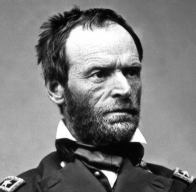
1863 – General William Tecumseh Sherman issued orders from a home in downtown Rome to General John Corse: “Tonight destroy all public property not needed by your command, all foundries, mills, workshops, warehouses, railroad depots, or other storehouses convenient to the railroad, together with all wagon shops, tanneries or other factories useful to the enemy. Destroy all bridges immediately, then move your command to Kingston.”
The burning of Rome marked the beginning of Sherman’s March to the Sea.
1885 – George Smith Patton, one of the great American generals of World War II, was born in San Gabriel, CA. Although Patton was one of the ablest American commanders in World War II, he was also one of the most controversial. He presented himself as a modern-day cavalryman, designed his own uniform, and was known to make eccentric claims that he was a direct descendant of great military leaders of the past through reincarnation.
1889 – Washington became the 42nd of the United States of America.

1918 – At the 11th hour on the 11th day of the 11th month of 1918, World War I – the Great War – ended. Germany, without manpower or supplies, and faced with imminent invasion, signed an armistice agreement with the Allies in a railroad car outside Compiégne, France. The First World War left nine million soldiers dead and 21 million wounded, with Germany, Russia, Austria-Hungary, France, and Great Britain each losing nearly a million or more lives. In addition, at least five million civilians died from disease, starvation, or exposure.
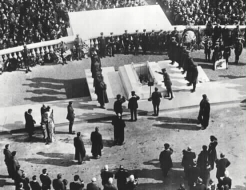
1921 – Exactly three years after the end of World War I, the Tomb of the Unknowns was dedicated at Arlington Cemetery in Virginia. Two days before, an unknown American soldier, who had fallen somewhere on a World War I battlefield, arrived at the nation’s capital from a military cemetery in France. On Armistice Day, in the presence of President Warren Harding and other government, military, and international dignitaries, the Unknown Soldier was buried with highest honors beside the Memorial Amphitheater. As the soldier was lowered to his final resting place, a two-inch layer of soil brought from France was placed below his coffin so that he might rest forever atop the earth on which he died.
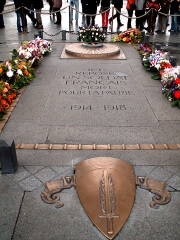
1923 – Beneath the Arc de Triomphe in Paris lies the Tomb of the Unknown Soldier. On this date, Andre Maginot, French Minister for War, lit an eternal flame, the first in Western and Eastern Europe since the fourth century.
In 1961, President John F. Kennedy and First Lady Jacqueline Kennedy paid their respects at the Tomb of the Unknown Soldier, accompanied by French President Charles de Gaulle. After the 1963 assassination of President Kennedy, Mrs. Kennedy remembered the eternal flame at the Arc de Triomphe and requested that an eternal flame be placed next to her husband’s grave at Arlington National Cemetery. President de Gaulle went to Washington to attend the state funeral, and witnessed Jacqueline Kennedy lighting the eternal flame that had been inspired by her visit to France.
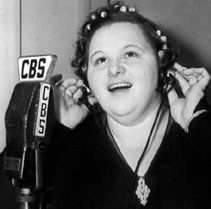
1938 – Kate Smith sang “God Bless America” for the very first time. It would later become her signature song. Irving Berlin wrote the tune in 1917 but never released it until Miss Smith sang it for the first time on her radio broadcast.
1940 – The Italian Navy lost half of its cruisers in one night when British naval forces blew them out of the water at the Battle of Taranto. The Italians suffered 660 casualties. The British lost 2 men.
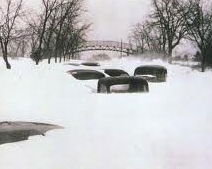
1940 – A blizzard cut a 1,000-mile-wide path through the middle of the country, from Kansas to Michigan. Early morning temperatures in the mid 60s plummeted over 50 degrees by nightfall when an intense low pressure system tracked from the southern plains into Wisconsin, pulling Gulf of Mexico moisture up from the south and pulled down an arctic air mass from the north.
The blizzard – which lasted through the next day – resulted in snowfalls of up to 27 inches, winds of 50-80 mph, and 20-foot snowdrifts. A total of 145 deaths were blamed on the storm.
1942 – Congress approved lowering the draft age to 18 and raising the upper limit to age 37. In September 1940, Congress, by wide margins in both houses, passed the Burke-Wadsworth Act, and the first peacetime draft was imposed in the history of the U.S. The registration of men between the ages of 21 and 36 began exactly one month later, but by 1942, with the United States now a participant in World War II, and not merely a neutral bystander, the draft ages had to be expanded; men 18 to 37 were now eligible.
Blacks were passed over for the draft because of racist assumptions about their abilities and the viability of a mixed-race military. But this changed in 1943, when a “quota” was imposed, meant to limit the numbers of blacks drafted to reflect their numbers in the overall population, roughly 10.6 percent of the whole. Initially, blacks were restricted to “labor units,” but this too ended as the war progressed, when they were finally used in combat.
1967 – Three U.S. prisoners of war, two of them African American, were released by the Viet Cong in a ceremony in Phnom Penh, Cambodia. The three men were turned over to Tom Hayden, a “new left” antiwar activist. U.S. officials in Saigon said that the released prisoners had been “brainwashed,” but the State Department denied it. The Viet Cong said that the release was a response to antiwar protests in the U.S. and a gesture towards the “courageous struggle” of blacks in the United States.
1973 – The Soviet Union announced that (because of its opposition to the recent overthrow of the government of Chilean President Salvador Allende) it would not play a World Cup Soccer match against the Chilean team on November 21, if the match were held in Santiago. The International Football Federation had given the Soviets until the 11th to decide whether they would play the game. With the Soviet refusal, the Federation disqualified the Soviet team from World Cup play.

1978 – A stuntman on the set of “The Dukes of Hazzard” launched the show’s iconic automobile, a 1969 Dodge Charger named the General Lee, off a makeshift dirt ramp and over a police car. That jump, 16 feet high and 82 feet long (its landing totaled the car), made TV history. Although more than 300 different General Lees appeared in the series, which ran on CBS from 1979 until 1985, this first one was the only one to play a part in every episode: That jump over the squad car ran every week at the end of the show’s opening credits.

1987 – Van Gogh’s Irises – painted in 1889 during the artist’s first week at the asylum at St. Remy – was sold at Sotheby’s in New York for $53.9 million.
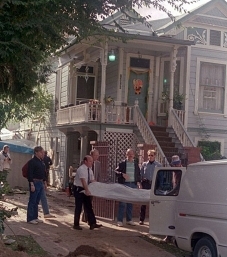
1988 – Authorities unearthed a corpse buried in the lawn of 59-year-old Dorothea Puente’s home in Sacramento, California. Puente operated a residential home for elderly people, and an investigation led to the discovery of six more bodies buried on her property. Puente was a diagnosed schizophrenic who had already been in trouble with the law. She had previously served prison time for check forgery, as well as drugging and robbing people she met in bars. After her release, she opened a boarding house for elderly people. Beginning in 1986, social worker Peggy Nickerson sent 19 clients to Puente’s home. When some of the residents mysteriously disappeared, Nickerson grew suspicious.
Although all the buried bodies were found to contain traces of the sedative Dalmane, the coroner was never able to identify an exact cause of death. Still, during a trial that lasted five months and included 3,100 exhibits, prosecutors were able to prove beyond a reasonable doubt that Puente had murdered her boarders, most likely to collect their Social Security checks. Though she was formally charged with nine counts of murder and convicted on three, authorities suspected that Puente might have been responsible for as many as 25 deaths.
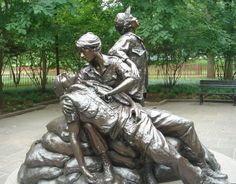
1993 – The Vietnam Women’s Memorial, dedicated to the women of the United States who served in the Vietnam War, was formally dedicated in Washington, D.Dc.
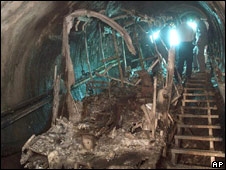
2000 – A cable car taking skiers to Kitzsteinhorn Mountain in the Austrian Alps caught fire as it passed through a mountain tunnel. 156 people died, with o nly 11 people managing to survive the fire, which was caused by an illegal space heater.

2004 – Mohammed Yasser Abdel Rahman Abdel Raouf Arafat al-Qudwa (better known as Yasser Arafat), the Chairman of the Palestine Liberation Organization, died of a stroke at the age of 75.
Compiled by Ray Lemire ©2014 RayLemire.com. All Rights Reserved.
You may not, under any circumstances, reproduce, record, publish, republish, post, transmit, publicly display, publicly exhibit or distribute any articles or photographs on RayLemire.com without obtaining the express written consent of the Operator.